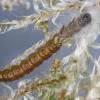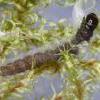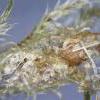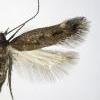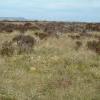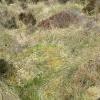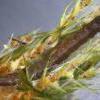35.042 Bryotropha boreella (Douglas, 1851)
Status and Distribution
A very local northern species occuring in a few upland areas of northern England, Wales and, more widely, in Scotland. The species has also been found on a central lowland moss, and at lower alitudes further north in Scotland.
Provisional map
Habitat
Damp to wet upland heathery moorland and, on occasions, upland herb-rich slopes. In western and north-west Scotland found in these habitats at lower altitudes and once on a moss in central lowland Scotland. The Malham location in Yorkshire is described as '1100 to 1200 feet.....the fringe of wet ground edged by birch, alder and various sallows, near which grows species of marsh plants...'. In Lancashire the two sites are quite different being a herb rich south-west facing steep slope and a large flat boggy area with plentiful ammounts of moss, cranberry, bilbery and heather atop a moorland ridge.
Finding the Moth
Larva: in small dense silk tubes amongst mosses a little down from the top of the mosses only being located by gentle parting of the fronds. It should be noted that the larva of Phiaris palustrana (see photos above) is very similar to that of B. boreella and that the obvious black pinacula present on B. boreella are the best feature to separate the two - the pinacula on P. palustrana are the same colour as the rest of the body. The larval spinning for the latter species does not form a tube and the larva is less active than that of B. boreella (Heckford, R. J., Beavan, S. D. & Palmer, S. M., 2015).
Adult: flies readily in the morning sun and can be swept or disturbed later in the day. Rarely attracted to light but has been reported from an actinic trap at one of its Yorkshire sites. It is reported in Europe that females remain hidden in the low vegetation much of the time. At the Lancashire sites this is probably the case as they have never been encountered despite searches. Smoking suitable areas may assist in finding them.
Similar Species
The forewing colour ranges from brownish-grey to lead-grey, occasionally blackish grey, the stigmata being reasonably distinct, worn specimens appear paler. The costal and tornal patches are a dirty creamy-white often extending to form an indistinct fascia. The forewing shape of the smaller female, which gradually widens in the first third and tapers beyond is diagnostic if rather tricky to see for this darkish-grey upland species. The males can be confused with dark forms of B. galbanella but are usually smaller and darker lacking the ochreous scales. In B. galbanella the inside of the labial palpus is generally pale yellow and pale grey in B. boreella. Both the male and female genitalia are similar to B. galbanella.
Single brooded from late June to early August.
Earliest: 17th June 2005 (VC48)
Latest: 10th August 1994 (VC107)

